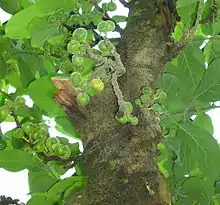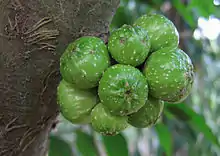Ficus hispida
Ficus hispida is a small but well distributed species of tropical fig tree. It occurs in many parts of Asia and as far south east as Australia.[1][2] There is a large variety of local common names. Like a number of ficus, the leaves are sandpapery to touch. An unusual feature is the figs which hang on long stems.
| Ficus hispida | |
|---|---|
 | |
| Scientific classification | |
| Kingdom: | Plantae |
| Clade: | Tracheophytes |
| Clade: | Angiosperms |
| Clade: | Eudicots |
| Clade: | Rosids |
| Order: | Rosales |
| Family: | Moraceae |
| Genus: | Ficus |
| Subgenus: | F. subg. Sycomorus |
| Species: | F. hispida |
| Binomial name | |
| Ficus hispida | |
| Synonyms | |
|
Ficus oppositifolia Roxb. | |

Fruits
Species associated with Ficus hispida
In Australia the fruit are eaten by cassowaries and double-eyed fig parrots. Phayre's leaf monkey feeds on the leaves as do the larvae of the moth Melanocercops ficuvorella. The fig wasp Apocrypta bakeri has F. hispida as its host, where it parasitizes the other fig wasp Ceratosolen solmsi. The yet unnamed nematode species Caenorhabditis sp. 35 has been found in Aceh, Indonesia, associated with the tree.
References
| Wikimedia Commons has media related to Ficus hispida. |
- "Ficus hispida". ZipcodeZoo. ZipcodeZoo. Archived from the original on August 30, 2010. Retrieved April 17, 2012.
- "Biotik.org". Ficus hispida. Archived from the original on July 25, 2010. Retrieved April 17, 2012.
This article is issued from Wikipedia. The text is licensed under Creative Commons - Attribution - Sharealike. Additional terms may apply for the media files.